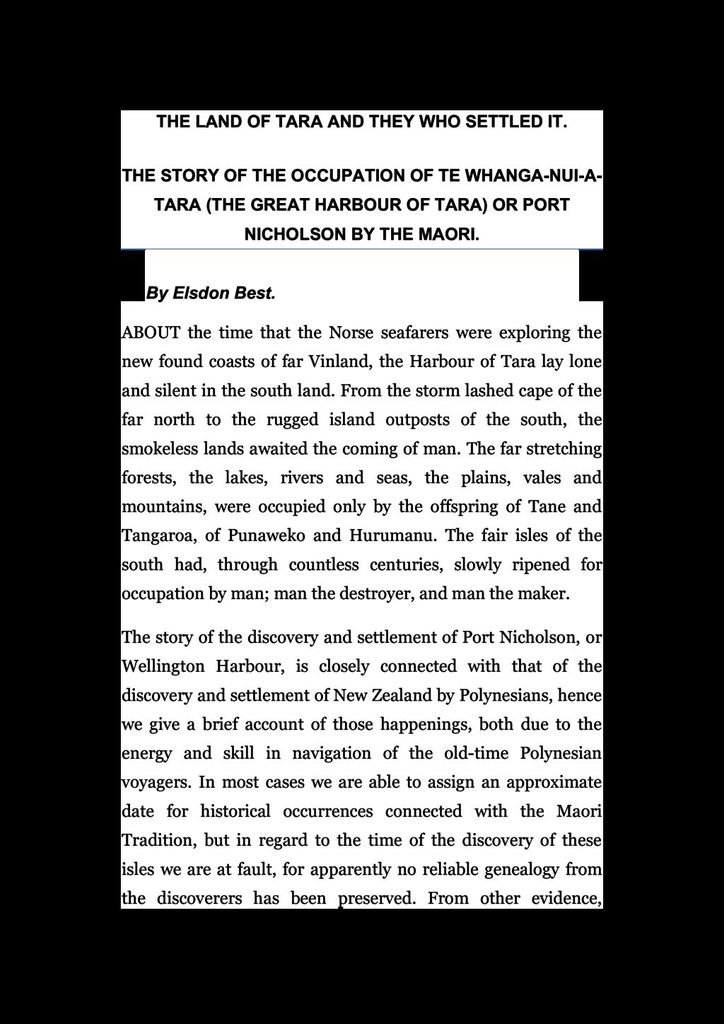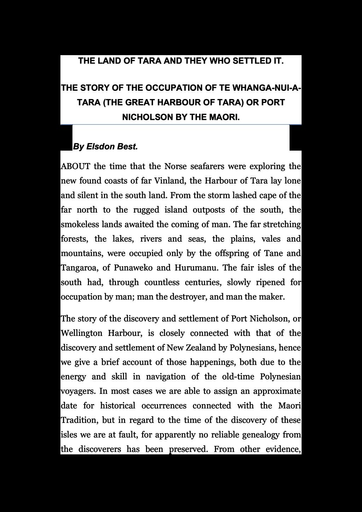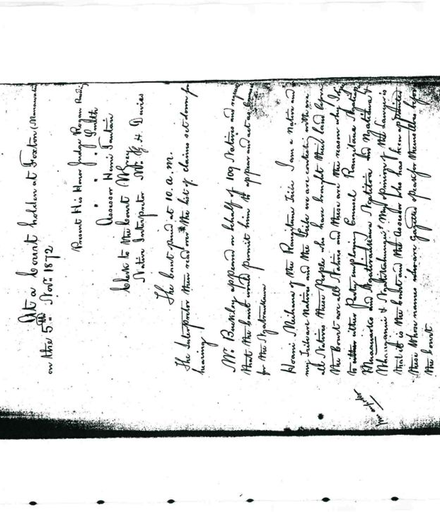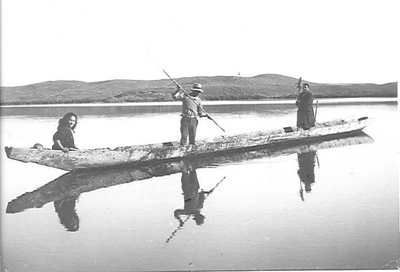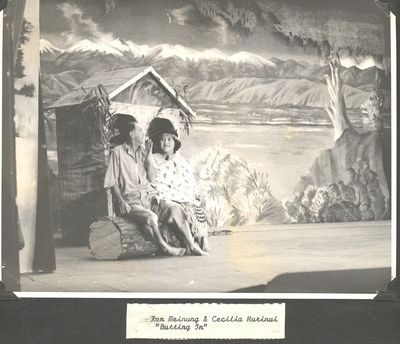The Land of Tara
- Description
THE LAND OF TARA AND THEY WHO SETTLED IT.
THE STORY OF THE OCCUPATION OF TE WHANGA-NUI-A-TARA (THE GREAT HARBOUR OF TARA) OR PORT NICHOLSON BY THE MAORI.
By Elsdon Best.
ABOUT the time that the Norse seafarers were exploring the new found coasts of far Vinland, the Harbour of Tara lay lone and silent in the south land. From the storm lashed cape of the far north to the rugged island outposts of the south, the smokeless lands awaited the coming of man. The far stretching forests, the lakes, rivers and seas, the plains, vales and mountains, were occupied only by the offspring of Tane and Tangaroa, of Punaweko and Hurumanu. The fair isles of the south had, through countless centuries, slowly ripened for occupation by man; man the destroyer, and man the maker.
The story of the discovery and settlement of Port Nicholson, or Wellington Harbour, is closely connected with that of the discovery and settlement of New Zealand by Polynesians, hence we give a brief account of those happenings, both due to the energy and skill in navigation of the old-time Polynesian voyagers. In most cases we are able to assign an approximate date for historical occurrences connected with the Maori Tradition, but in regard to the time of the discovery of these isles we are at fault, for apparently no reliable genealogy from the discoverers has been preserved. From other evidence, however, we can assume that such discovery was made not less than forty generations ago, or say the tenth century.
The first voyagers to reach these isles are said to have been two small bands of adventurers from Eastern Polynesia, who, under the chiefs Kupe and Ngahue (also known as Ngake), reached these shores in two vessels, probably outrigger canoes, named ‘Mātāhorua’ - 144 and ‘Tawiri-rangi.’ We are told that Kupe was accompanied by his wife and children, and this is probably correct, for the Polynesian voyagers often carried their women folk with them on deep sea voyages, even as Maori women accompanied their men on war expeditions. The wife of Kupe, one Aparangi by name, was a grand-daughter of Poupaka, whom tradition claims to have been a famous and bold navigator, though tradition claims too much for him when it dubs him the first deep-sea sailor, for at that period the Polynesians had sailed far and wide athwart the great Pacific Ocean. However, it is well to extol one's own ancestors. Part of the tradition reads:—“It was Poupaka who began sailing abroad on the ocean, when all others feared to do so on account of their dread of Tawhirimatea and his offspring (personified forms of winds), hence the following saying became famous:—‘Tutumaiao Tawhirimatea, whakatere ana Poupaka,’ as also this:—‘Tutu te aniwaniwa, ka tere Poupaka i te uru tai.’”
The story of the coming of Kupe is encrusted with myth, and there are several versions as to the cause of his coming. One of these versions is to the effect that his daughter Punaruku was slain while bathing at Wai-o-Rongo, at Rarotonga, where she was attacked and, as our mythopoetic Maori puts it ‘carried off to Tai-whetuki,’ the house of death. Kupe pursued the monster who had slain his daughter across far ocean spaces until he finally caught and slew him at Tua-hiwi-nui-o-Moko, in Cook Straits, assisted by his nephew Mahakiroa. Others who assisted him were his relatives Tipua, Kaiponu, Awa-pururu, Te Awa-i-taia, Maru-hangahanga, Maru-ehu, Hau-puhi, and his attendants Komako-hua, Popoti and Ahoriki. The following table shows the position of persons mentioned in this tradition in regard to Kupe. It was given by Te Matorohanga 1 of Wai-rarapa, and shows Matiu and Makaro as nieces of Kupe, instead of daughters as they appear in another version:—
It is unnecessary to give the full account of the voyage of Kupe and Ngahue from Eastern Polynesia to Aotearoa, as he named New Zealand; we will confine ourselves to that part of it that affects the Wellington district. Kupe was a chief who possessed interests in three different islands, for his father belonged to Hawaiki, by which name the island of Tahiti seems to have been known, his mother was a native of Rarotonga, while his maternal grandfather was of Rangiatea, now called Ra'iatea (one of the Society Islands).
After a weary voyage across the southern ocean, one day a low hung cloud attracted attention. Quoth Kupe, “I see a cloud on the horizon line. It is a sign of land.” His wife cried, “He ao! He ao?” (A cloud! A cloud!) That cloud betokened the presence of land, rest and refreshment for cramped and sea racked voyagers. The two vessels made the land in the far north, where the crews remained for some time, after which they continued their voyage down the east coast of the North Island. On the way down Kupe named Aotea island (the Great Barrier), and the mainland was named Aotearoa, after the white cloud greeted by his wife Hine Te Aparangi (ao tea=white cloud). The longer name may thus be rendered as Greater Aotea, or Long, or Great Aotea. When Kupe returned to Hawaiki from these isles, the people asked him:—“Why did you call the new found land Aotearoa, and not Irihia or Te Hono-i-wairua, after the homeland our race originated in?” But Kupe replied:—“I preferred the warm breast to the cold one, the new land to the old land long forsaken.”
Our voyagers stayed a while at Castle Point (Rangi-whakaoma) and then came on to Palliser Bay, where they remained for some time to refit, at a place called Te Matakitaki-a-Kupe, so named by his daughter Hine-uira, because, from a rock at that place, Kupe looked upon the South Island and Mt. Tapuae-nuku (matakitaki=to inspect, look at). In a saltwater pool at Te Kawakawa Kupe is said to have kept two kinds of fish known as kahaparu and ngongopuni. We are told that Kupe left Rere-whakaaitu at this place, Matauranga at Turaki-rae, Kahukura-a-tai at the entrance to the Whanga-nui-a-Tara, and Matiu and Makaro within the harbour, while he went on to the South Island after exploring Wellington Harbour. All these folk gave their names to the places they were left at, which probably means that places were named after them, and not necessarily that they lived or camped at all of them.
Our seafarers now came on from Palliser Bay, and entered the harbour, landing at Seatoun, the foreshore of which place is known as the Turanga-o-Kupe, possibly so named from the fact that the sea rover was hurt against a rock when bathing at the Pinnacle Rock, known as the Aroaro-o-Kupe. While encamped at this place Matiu and Makaro are said to have named the two islands, Somes and Ward, after themselves. Rocks in the sea at Sinclair Head and Tongue Point are said to have been named Mohuia and Toka-haere after two of the daughters of Kupe.
Hori Ropiha, of Napier, remarks that Kupe and Ngake (Ngahue) distributed their children all round Aotearoa. Their food was wind alone, and in these days those folk bear the aspect of rocks. The following lines from an old song refer to these occurrences:—
“He uri au no Kupe, no Ngake
E tuha noa atu ra kia pau te whenua
Te hurihuri ai ko Matiu, ko Makaro.”The Maori, with his mythopoetic mind, would not state baldly that certain places, rocks, islets, etc., were named after these personages.
Hori goes on to relate the old myth that Kupe left here the obstructions to travellers by land, such as the ongaonga (nettle, Urtica ferox), the tumatakuru (Discaria toumatou), and papaii (Aciphylla), which were burned in after times by Tamatea of Takitumu, an immigrant from the Society Group. Again we refer to a reference in song:—
“Nga taero ra nahau, e Kupe!
I waiho i te ao nei.”(The obstructions there, by thee, O Kupe! left in the world.)
Another old local myth is to the effect that our harbour was at one time a lake in which dwelt two monsters named Ngake and Whataitai (syn. Hataitai, the native name of Miramar peninsula). These two beings attempted to force their way out of the harbour. Ngake succeeded by forming the present entrance, but Whataitai failed in a similar attempt at Evans Bay. Hence he assumed the form of a bird and betook himself to the summit of Tangi-te-keo (Mt. Victoria), where his shrieks were plainly heard.
In the quaint conceit in which the North Island is called Te Ika-a-Maui (Fish of Maui), Wellington Harbour is styled the right eye of the fish, and Wai-rarapa Lake the left eye.
Leaving Wellington Harbour our seafarers moved on to Sinclair Head, where they camped for some time in ordor to lay in a stock of sea stores in the form of dried fish and shellfish, for which that place has ever been famed in Maori annals. Here also they procured quantities of rimurapa (D' Urvillea utilis), the great wide stems of which they utilised as vessels (poha) in which to store and carry their dried foods, a use to which this giant seaweed was frequently put by the Maori. It was on this account that the party named Sinclair Head Te Rimurapa. The point near this head known to us as the Red Rocks is called Pari-whero, or Red Cliff by natives, on account of the peculiar colour of the slate rock in that vicinity. Here are two old myths concerning the origin of such redness. One is a somewhat prosaic one, namely that Kupe had his hand clamped by a paua (Haliotis) so severely that the flowing blood stained the surrounding rocks, as also the ngakihi (limpet, Patella) of the adjacent waters. The other version sounds better, and is to the effect that Kupe left his daughters at this place while away on one of his exploring trips. He was away so long that the maidens began to mourn for him as lost to - 148 the world of life. They lacerated themselves after the manner Maori, even so that the flowing blood stained the rocks of Pari-whero for ever.
Moving on from Sinclair Head the rovers stayed a while at Owhariu, and then went on to Porirua Harbour. While at this place one of Kupe's daughters is said to have found on the beach at the northern side of the entrance a stone higly suitable for a canoe anchor, hence it was placed on board ‘Matahorua’ to be used for that purpose. This stone anchor was named Te Huka-a-tai because such is the name of the kind of stone it was composed of. On account of this occurrence Kupe left one of his stone anchors at Porirua; one named Maungaroa because he had brought it from a place named Maungaroa at Rarotonga in the Cook Group. This anchor is said to have been carefully preserved for centuries, and is now in the Dominion Museum, Wellington. Long years ago old Karehana Whakataki of Ngati-Toa conducted the writer to a spot near, and on the eastern side of the railway line at Paremata, a few hundred yards north of the bridge, and there showed him Kupe's anchor. It is a heavy and unwieldly waterworn block of greywacke, of a weight that casts a doubt on the assertion that it was used as a canoe anchor, certainly it could not be handled on any single canoe. A smooth faced hole through one corner of it is said to have been where the cable was attached, but it bears no sigh of human workmanship. This change of anchors is said to have been the origin of the name Porirua, but the statement is by no means clear. We know of no meaning of the word pori that throws any light on the matter.
The voyagers went to Mana Island, off Porirua Heads, where Mohuia suggested that the island should be so named as a token of the mana (authority, etc.) of the voyagers, which was agreed to. This name origin is by no means clear, for the name of the island is pronounced Mānă, whereas in the other word both vowels are short, mănă, and the correct rendering of vowel lengths is most essential in Maori. A point or headland at Ra'iatea island is known as Mānā, and it may be thought that the name is a transferred one that has been corrupted, but this seems doubtful. A native writer, however, seriously enough, gives the island name as Manaa to show that the final vowel is long, but as this method of denoting long vowel sounds is never consistently followed by any native, we are still in doubt concerning the first syllable
From Mana Island the explorers crossed Cook Straits, went down the West Coast of the South Island, and, at Arahura, discovered greenstone, a very important occurrence in Maori history, of such value was that hard and tough stone to them in the manufacture of implements. Here also at Arahura the explorer Ngahue is said to have slain a moa at or near a waterfall in the river. On his return - 149 home to Hawaiki he reported that the most remarkable products of Aotearoa were greenstone (nephrite) and the moa.
The explorers coasted both islands ere they left on their return voyage, but these further adventures do not concern our harbour story. On his return Kupe visited Rarotonga, Rangiatea, Tonga, Tawhiti-nui, and Hawaiki, that is Titirangi, Whangara, Te Pakaroa, and Te Whanga-nui-o-Marama, and at these places gave an account of his voyage, and of the moisture laden land he had discovered at tiritiri o te moana, that is, in the great expanse of the southern ocean. Here Kupe the voyager passes out of our story.
The interesting feature of this voyage is that the discoverers of these isles came to a lone land. They found here no human inhabitants, according to tradition, but when the next Polynesian voyagers reached these shores they found a considerable part of the North Island occupied by man, showing that probably not less than eight or ten generations had passed since the time of Kupe.
Identification
Taxonomy
- Community Tags


